ARTICLE AD BOX
Photographs by Cole Barash
This article was featured in the One Story to Read Today newsletter. Sign up for it here.
Two weeks before chaos hit St. Luke’s hospital in Boise, Idaho—before Ammon Bundy showed up with an armed mob and the hospital doors had to be sealed and death threats crashed the phone lines—a 10-month-old baby named Cyrus Anderson arrived in the emergency room.
The boy’s parents, Marissa and Levi, knew something wasn’t right: For months, Cyrus had been having episodes of vomiting that wouldn’t stop. When he arrived in the ER, he weighed just 14 pounds, which put him in the .05th percentile for his age. Natasha Erickson, the doctor who examined him, had seen malnutrition cases like this in textbooks but never in real life. Cyrus’s ribs were clearly visible through his chest. When he threw up, his vomit was bright green.
Erickson hooked the baby up to an IV and a feeding tube, and he slowly started to gain weight. But Levi and Marissa were anxious to leave. They were members of an anti-government activist network that Bundy, the scion of America’s foremost far-right family, had founded, and they shared his distrust of medical and public-health authorities. To Marissa—whose father, Diego Rodriguez, is himself an extremist leader and Bundy’s close friend—the hospital was a “lion’s den.”
By the next evening, Levi and Marissa were demanding to take their baby home, but hospital staff said it wasn’t yet safe. They left a few days later, with instructions to bring Cyrus in for follow-up appointments. When they failed to show up for a scheduled weigh-in at a local clinic the following week—Marissa was feeling sick herself and decided to postpone it—a nurse there referred the case to the Idaho Department of Health and Welfare. Cyrus missed another appointment that afternoon at St. Luke’s, and another nurse contacted the detective on the case. Someone had to see the infant right away, she said.
That night, officers pulled the family over at a gas station in nearby Garden City. Marissa begged for Bundy’s help by phone. “They’re trying to take my baby. They’re trying to take my baby,” she kept telling him, until she was out of breath. Police lights were flashing all around her as a crowd began to gather. She couldn’t understand how things had escalated so fast.
Bundy put out a call for help from his group, the People’s Rights Network, which claimed to have more than 50,000 members, and told Marissa to livestream what was happening on Facebook. When a police officer demanded that she hand Cyrus over, she pleaded with him. “Do you understand what happens when the state takes custody of babies?” she said. “I’ve seen this so many times. I can’t be that next person—I can’t.” While Bundy was driving to the gas station, he learned that both Levi and Marissa had been arrested, and Cyrus was on the way to another St. Luke’s branch, an ER about 10 miles away in Meridian. Bundy and his supporters headed there.
Within an hour, a small crowd was blocking the ambulance bay, forcing the hospital to divert patients elsewhere. Protesters shouted that the hospital staff were kidnappers and child molesters. Some followed nurses to their cars as they left the building. Bundy himself was arrested for trespassing on hospital property, and Rachel Thomas, the lead doctor in the ER that night, feared that the crowd would break down the doors and try to take the baby.
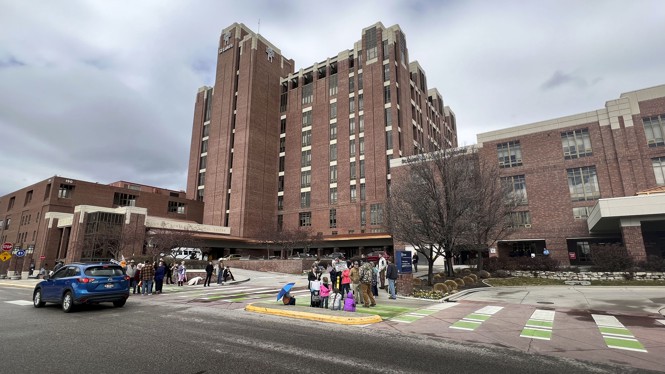 Protesters gather outside St. Luke’s Boise Medical Center in downtown Boise, Idaho, in March 2022. (Darin Oswald / Idaho Statesman / AP)
Protesters gather outside St. Luke’s Boise Medical Center in downtown Boise, Idaho, in March 2022. (Darin Oswald / Idaho Statesman / AP)
In the early hours of the next morning, after getting out of jail, Bundy posted a video urging more of his followers to join the protest. “It’s just sickening, sickening, sickening,” he said. “These people believe they have the authority to take our little babies. They are wicked.”
By that time, it was clear to Dr. Thomas that the child had to be moved back to the hospital in Boise as quickly as possible for security reasons. She wrapped Cyrus in a blanket and carried him through the bowels of the hospital to an ambulance at a back entrance. Security officers led the way, searching each area for intruders before giving the “all clear” and letting her enter. She felt like she was in a cheap action movie. To avoid the crowd, the ambulance jumped the median as it made a U-turn and sped east on I-84.
Dr. Erickson met Cyrus on his arrival. He looked even sicker than he had the week before. His weight now put him below the .02nd percentile. As doctors reinserted the IV and the feeding tube, Bundy sent out a new People’s Rights alert redirecting the crowd to the Boise campus. Protesters arrived with Free Baby Cyrus signs. Bundy told his followers to call St. Luke’s, and soon threats were pouring in by the hundreds.
“The parents of a child have all the rights,” one caller said. “I need you to remind everybody who works there before we come and lop off your fucking head, bitch. We will fucking kill you.” Rodriguez, Marissa’s father, began holding regular rallies at the hospital and at one of them called on God to “crush the necks of those that are evil.” Three days into this ordeal, the FBI and state authorities warned St. Luke’s that some of Bundy’s followers were planning to storm in and take the baby by force. About 30 Boise police officers were called in. Hospital workers constructed a barricade of furniture to block access to the children’s wing.
As the protest escalated, Health and Welfare workers spirited Cyrus to a secret location, where they babysat him in shifts. A few days later, and about a pound heavier, he was returned to his parents. The protesters dispersed, and Bundy and Rodriguez celebrated. Cyrus’s return home, Bundy said, was nothing short of “a miracle.”
In the months that followed, Bundy pleaded guilty to misdemeanor trespassing at the hospital and avoided time in jail. But the protests he and Rodriguez had fomented with their false accusations of child trafficking resulted in a civil suit against them. This past August, after a weeklong trial that Bundy and Rodriguez skipped, a judge assessed $52 million in damages, almost certainly more than their combined net worth.
Bundy has promised to hold firm. If the county sheriff ever showed up on his property to collect, he told one interviewer, he’d “meet ’em at the front door with my friends and shotgun.”
In early August, I flew out to Idaho to visit Bundy. But at 3:11 a.m. the night before we were scheduled to meet, he texted me to cancel. He was on the verge of financial ruin, he said, and it was getting harder and harder to shield his children from the effects. The message went on for some 230 words about how a man described as one of America’s most dangerous right-wing extremists was “fighting a lot of emotional anxiety.”
If he did confront the sheriff, it wouldn’t be the first time his family had done battle with the law. In 2014, about a thousand militiamen and other supporters helped his family repel government agents trying to impound their cattle in Bunkerville, Nevada. Bundy’s followers still speak with awe about how officers Tasered him three times, and three times, with the help of the crowd behind him, he ripped out the Taser darts and stood his ground. His father, Cliven, led that battle, but when the Bundys clashed with government agents again in 2016, Ammon was in charge. His six-week occupation of an Oregon wildlife refuge left a rancher dead, shot down by police officers after a backwoods car chase.
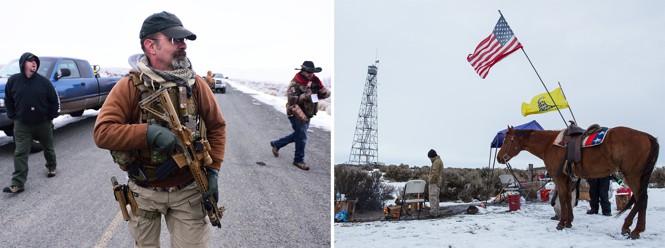 Left: An armed man stands guard as Bundy supporters arrive at the Malheur National Wildlife Refuge in January 2016. Right: Early morning at the front-gate guard post during the occupation. (Alex Milan Tracy / AP; Jeffrey Schwilk / Alamy)
Left: An armed man stands guard as Bundy supporters arrive at the Malheur National Wildlife Refuge in January 2016. Right: Early morning at the front-gate guard post during the occupation. (Alex Milan Tracy / AP; Jeffrey Schwilk / Alamy)
In 2020, with the start of the pandemic, Bundy found a new purpose. One of the first meetings of his People’s Rights Network, held in April of that year, was to plan an Easter service in defiance of local COVID-19 restrictions. At another early demonstration, members gathered outside a health commissioner’s home in Montana and burned masks on a grill. In August 2020, Bundy was arrested and jailed after leading a contingent of supporters, some with guns, as they stormed the Idaho statehouse, pushing officers and shattering a glass door, during a special legislative session on public-health precautions.
When People’s Rights members started telling Bundy about how the government was unjustly separating children from their parents, that became another cause. Instances of actual overreach by Child Protective Services became, for them, evidence supporting QAnon-style conspiracy theories about “government subsidized child trafficking,” as Rodriguez put it, which were proliferating in extremist circles and beyond. By the time Cyrus was taken, People’s Rights members had already staged protests on behalf of supposedly “kidnapped” children in Missouri, Oregon, and Washington. But none of those had escalated like the one at St. Luke’s.
Despite his late-night text, Bundy did in the end agree to see me, for what was supposed to be a quick hello but stretched into a day-long visit. I’d spend more time with him in the weeks that followed, and speak with him regularly on the phone. We discussed many aspects of his life, but most of all we talked about the judgment against him, and what would happen if the government tried to take his home.
“I feel like I’m not supposed to yield,” he told me at one point. If he were killed, he said, his friends and followers would avenge him: “They’ll go take the life of the judge and the sheriff and St. Luke’s CEO and the head attorney and all the most culpable people.” He delivered these words with an unnerving lack of menace—less like a threat than like a weather forecast.
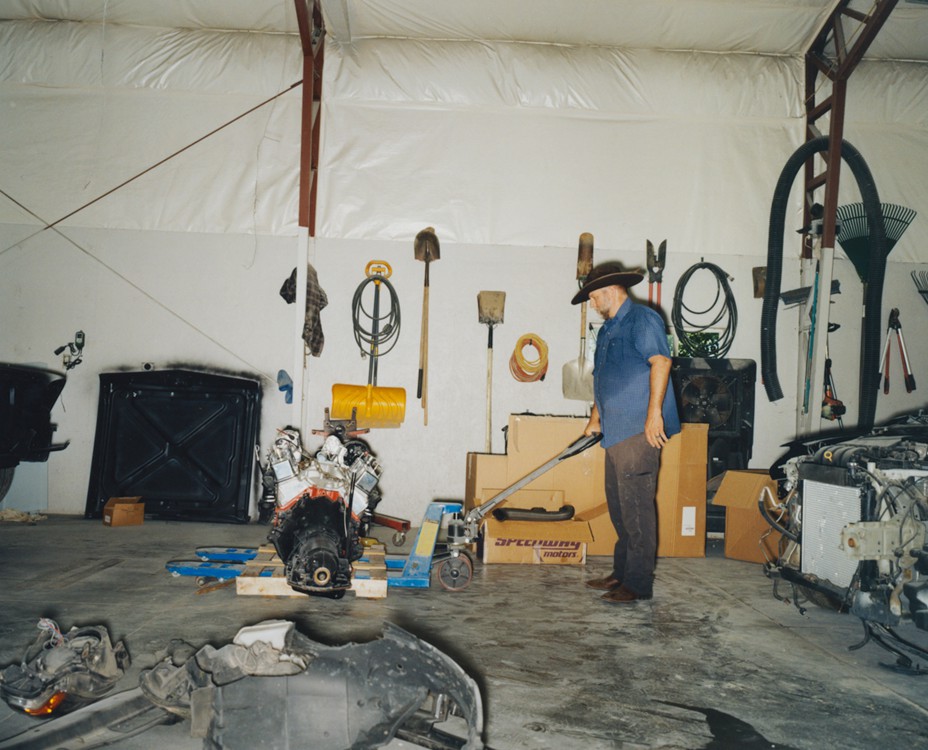 Ammon Bundy in his auto-repair workshop
Ammon Bundy in his auto-repair workshop
Bundy’s home sits on a five-acre property at the edge of Idaho’s Emmett Valley, just across the road from Last Chance Canal. If he could choose any place in the world to live, he told me, it would be here.
When I showed up, I found him pacing around his auto-repair workshop, looking for parts. His beard is almost fully gray, and at 48, he has a bit of a belly, which he finds embarrassing. As always, he wore a chocolate-brown cowboy hat and a mechanic’s jacket with the logo of the fleet-maintenance company he once ran. He’s worked on cars ever since he was a teenager, when his father told him that the family ranch could not sustain him and his siblings.
Ammon was the fourth of six children of an unhappy marriage. Cliven was often away, working construction jobs in Las Vegas. Ammon’s mother, Jane Marie, resented the lonely domesticity she’d been consigned to, he told me. When he was 5 years old, she left. One night soon after, a huge storm took down a tree in the yard. The next morning, as he and his siblings played in the wreckage, he remembers thinking, Where’s Mom? She had not said goodbye.
With their mother gone and their dad away, the Bundy children mostly raised themselves. Instead of doing homework, Ammon and his brothers hunted rabbits in the hills and built Quonset huts. After high school, he went on his Mormon mission to Minnesota and then started a truck-repair business. A couple of years later, he married Lisa Sundloff, a student at Southern Utah University whom he met through his secretary, and they moved to Arizona.
Their first apartment was tiny, but as Bundy’s business took off, they moved into a house in the Phoenix suburbs, then a bigger one with a stone fireplace and a swimming pool, a home he still speaks of with pride. He didn’t drink or smoke; he had five kids and avoided trouble with the law. He leaned libertarian, but he was no militant: In 2010, he took out a $530,000 loan from the Small Business Administration.
It isn’t easy, now, to reconcile that law-abiding suburban dad, his growing business supported by a federal loan, with the man he has become. Thirteen years and two standoffs later, Ammon believes the proper functions of government are limited to preventing violent crime, protecting private property, and defending the country from foreign threats. He says that abortion is murder and homosexuality is an abomination, but also that the government doesn’t have any business outlawing gay marriage (though it should prohibit same-sex couples from raising children). He opposes a border wall and views Trumpian policies as insufficiently compassionate, a position for which he has been criticized by other prominent right-wingers. He thinks it would perhaps be best if the country were divided in half before a partisan civil war breaks out.
At one point, he asked about my faith, and when I said Jewish, he remarked on how interesting it is that Jews hold so many positions of power in government, media, and finance. Somehow this didn’t sound like conspiracism, the way he said it. More like: Well played, Jews, from our small religious minority to yours.
Invariably, though, conversation turned back to his current predicament. He ranted for hours about the corruption of the government, the corruption of medical institutions, the corruption of the Church of Jesus Christ of Latter-day Saints. The courts, he said, are simply a “playbox” for the rich and powerful, a place for them to justify their misdeeds. Though he’d been cleared of any crime associated with the standoffs in Oregon and Nevada, the final legal victory came after he’d already spent nearly two years in prison, much of it in solitary confinement, he said. By the time he was released, his business had all but collapsed, and he’d missed those years of his children’s lives. “That changed me,” he said. It taught him that even when you win, the process is the punishment.
I asked Bundy what he thinks motivates his many enemies, and how he accounts for so much wickedness. He reached for the Book of Mormon, put on his glasses, and began to read aloud. The passage he’d chosen told the story of Jared, a prince who devises a scheme to have his father beheaded and seize the throne for himself. The conspirators form “a secret combination,” which is “most abominable and wicked above all, in the sight of God,” and their scheme succeeds.
That is what Ammon Bundy believes is happening in America. His enemies, motivated by the desire for power, have formed secret combinations, which threaten, as the Book of Mormon warns they will, to “overthrow the freedom of all lands, nations, and countries.”
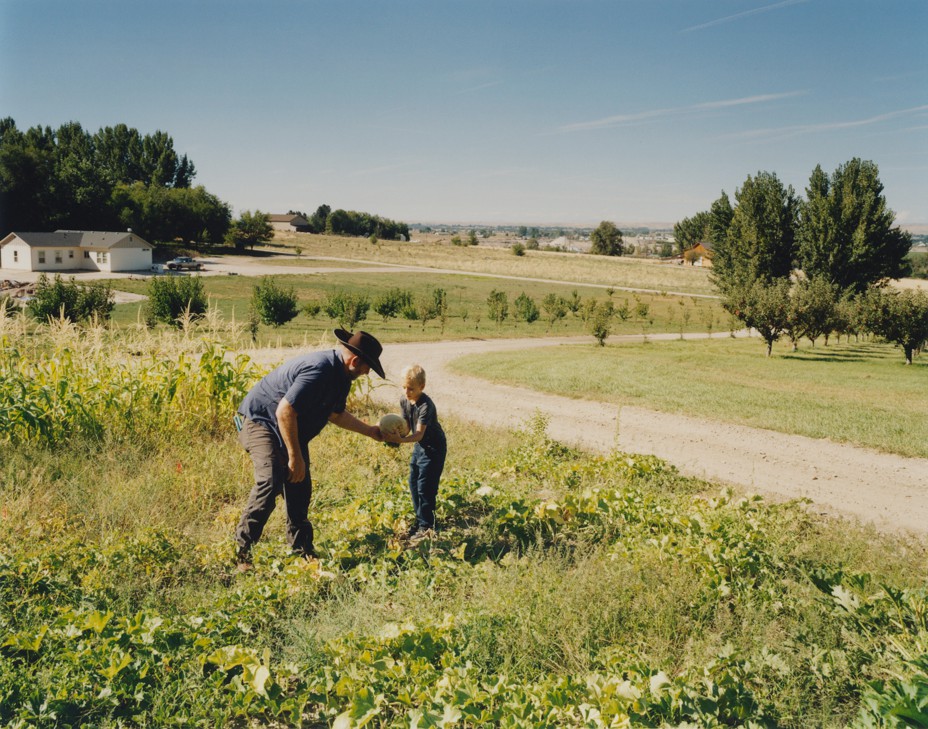 Ammon Bundy with one of his sons in Emmett
Ammon Bundy with one of his sons in Emmett
That night, I tagged along with Bundy to a barbecue hosted by Scott Malone, a friend of his who runs a dietary-supplement business and lives just down the road. About 30 people, many of them members of the LDS Church and most of them members of People’s Rights, sat at picnic tables with checkered tablecloths eating burgers and hot dogs and peach cobbler. After dinner, we played cornhole.
“I’m pretty much into conspiracy theories,” Malone told me. A sprawling web of nefarious forces is undermining our freedom, he explained, at the center of which are the Freemasons. In Gem County, where he and Bundy live, the sheriff and his deputies are all Masons. Malone knows this because he rents office space directly below the Masonic lodge, and he says he sometimes catches evil spirits wandering around the office on his security cameras. To cast them out, he performs exorcisms. “We think the basement has some kind of an underworld connection,” he said. “Crazy things, but we take it in stride.”
When Ammon launched the People’s Rights Network in early 2020, Malone was an early member. The group is sometimes described as a paramilitary organization—a sort of “Uber for militias.” That description is not wholly inaccurate, but it is misleading. People’s Rights’ membership does overlap with that of militias like the Oath Keepers and the Three Percenters, and it serves in part to connect groups like these around the country. But it’s much bigger than those other groups, and it draws in people who would never join a traditional paramilitary organization. Most of its activities are mundane. Some members use the network to trade and barter; others organize workshops with naturopathic doctors. When one member’s truck broke down in early August, he put out a call via People’s Rights for someone to pick him up. In that sense, the group is less of a militia than a mutual-aid organization, where the aid sometimes takes the form of armed resistance to perceived despotism.
Which is not to say that it doesn’t pose a threat. In addition to the protest at St. Luke’s and other instances of potentially dangerous intimidation, one member got into a shootout with police after a traffic stop in 2020. And its leaders have stated plainly that bloodshed is not only justified but necessary for resisting tyranny. “There is no silver bullet to securing liberty,” Bundy himself wrote on the People’s Rights website. “It is going to take unity, suffering and the willingness to use violence in defense.” The Institute for Research and Education on Human Rights, which monitors extremist organizations such as the Oath Keepers and the Proud Boys, ranks Bundy’s group “at the top of our threat matrix.”
Beyond some basic tenets and anxieties of extreme libertarianism, those in Bundy’s group don’t agree on much. Some are fans of Donald Trump; others aren’t. Few would say that they support the police. Each seems to have his or her own peculiar origin story. While visiting Bundy, I met a onetime Ron Paul delegate who’d grown disillusioned with the Republican Party and stepped away, only to be drawn back in by the imposition of pandemic-era “Sharia law.” I met a former foster child turned chain-smoking Hempfest organizer who tried to live as a hermit before deciding that the only answer to government tyranny was active resistance. I met a Black kickboxing champion who has an on-screen credit in a Mad Max movie and, over the course of a decade, went from protesting the gentrification of Boise’s historically Black neighborhoods to sketching a portrait of Barack Obama with swastika-pupils.
And I met Malone, who may well be Bundy’s most loyal supporter. “He’s a good man, and I love him as a brother,” Malone told me. “I told my wife, ‘If I die with him, I die with him … I’m 72, and if this is how I end my life, then that’s how it ends. It couldn’t happen in a better way.”
By 9 o’clock, the party was winding down. The group prayed for me, just as they had when I’d arrived. (“We’re also grateful for our new friend, Jacob. Please bless him and help him on his journey and on his way.”) A grandmotherly woman who seemed genuinely concerned for my health warned me to stay away from the COVID vaccine. Another told me to be very careful driving home at this hour. A kid who’d recently returned from his Mormon mission invited me to go fishing the next day. Over the course of the evening, several people joked about the media calling them a militia. A militia?! they seemed to say. Just look at us!
As the sky darkened, everyone gathered in a circle to sing hymns. Bundy sat with his youngest son on his lap, the sunset at his back.
The next day, I met with Rachel Thomas, the ER doctor who’d ferried baby Cyrus to the back exit of the Meridian hospital as the mob pressed in. We sat at a small round table in a Boise coffee shop while her 6-year-old son ate a chocolate-chip muffin and watched Minions on his iPad for the dozenth time.
As we talked, Thomas noticed that a user named “Wolf Man” had just left a series of comments on her Facebook profile calling her a criminal and a perpetrator of “vile,” “disgraceful and appalling” acts. The comments linked to a new YouTube video Bundy had posted about the St. Luke’s case that very morning. “See, this is the problem with people like Rachel Thomas,” he says to the camera, after offering a litany of examples of her alleged dishonesty. “They are revered by the public because they are doctors and professionals, but they have no scruples. They are liars.”
With each new post like this, Thomas told me, the harassment ramps up again. “This is my life,” she said. “The second I feel like I can take a breath, they come after us again.” She pointed at her son, oblivious and chocolate-smeared behind her. “He didn’t sign up for this.”
For Natasha Erickson, the St. Luke’s pediatrician who first saw Cyrus, the threats and abuse began immediately and never stopped. Diego Rodriguez posted her photo and hospital bio on his website under the heading “Child Trafficker Profile.” “It is obvious she has a ‘god complex,’” he wrote, “and loves to threaten families using CPS as a weapon.” Bundy posted a video of his own calling Erickson “a wicked person for instigating this.” They said that she’d run unnecessary tests on Cyrus in order to profit off him and that she’d misdiagnosed his mild dehydration as life-threatening malnutrition. Commenters asked her how she’d feel if her kids were stolen.
 Supporters gather on Bundy’s property after a judge issued a misdemeanor warrant for his arrest for contempt-of-court charges in April 2023. (Kyle Green / AP)
Supporters gather on Bundy’s property after a judge issued a misdemeanor warrant for his arrest for contempt-of-court charges in April 2023. (Kyle Green / AP)
Erickson was less worried that large numbers of people would end up believing these claims than that a delusional person would take it upon himself to exact justice. She attached an emergency whistle to her purse, and her husband started carrying his handgun around whenever they were in public. She forbade her kids from playing in the front yard or answering the door, no matter who they thought was on the other side. The locks stayed bolted at all times.
For a while, Erickson was obsessed with what Bundy and Rodriguez were saying about her. She’d check their websites two or three times a day. At the grocery store, she was constantly afraid of who might be in the next aisle over. She took to wearing sunglasses whenever she could. Almost every time she saw a new patient, she worried that the parents might have seen her “Child Trafficker Profile,” and that they might genuinely believe it. So much of her job had been about forging personal connections with the “kiddos”: You like unicorns? My children love unicorns. But now even that felt fraught. When one child’s father asked her how old her kids were, she froze, retreated to the nurses’ station, and broke down sobbing. She considered leaving medicine entirely.
Both she and Thomas testified in the defamation case against Bundy and Rodriguez; so did a nurse who had seen Cyrus for a checkup and then coordinated his care for weeks after. But whereas Erickson and the nurse were named as plaintiffs, Thomas was not, because at the time St. Luke’s filed the lawsuit, she hadn’t yet been doxxed. She wound up getting the worst of both worlds: all of the harassment, none of the money.
This past summer, as she was driving with her son, he asked her out of the blue if “that Ammon Bundy guy” was gone yet, and whether he might hurt them. “No, buddy, we’re going to be okay,” she told him. By that point, the family had already taken steps to ensure their safety. In September, they packed up for New Zealand. They plan to stay for at least a year.
In between my trips to Bundy’s land in Idaho, I made a stop in Bunkerville, Nevada, to visit his father at the family ranch. When I got there, Cliven Bundy was sitting in a black leather recliner beneath a portrait of him by Jon McNaughton, the realist painter famous for his hagiographic renderings of Donald Trump. In the portrait, titled “Pray for America,” Cliven rides on horseback and raises an American flag. In the flesh, he chuckled a lot in a folksy-grandpa sort of way and held forth for some three and a half hours in his high-pitched rasp about faith, politics, biodiversity, and his decades-long conflict with the U.S. government.
If you were to tell the complete story of that conflict, you could begin in 1844, with the murder of Joseph Smith. Or you could begin in 1877, with the arrival of the Bundy family’s ancestors in Utah’s Virgin Valley. Or in 1934, with the Taylor Grazing Act. Or even in 1976, with the Federal Land Policy and Management Act. But you could not begin any later than 1989, with the Mojave desert tortoise. That year, the tortoise was given an emergency endangered-species designation, and as part of its recovery plan, the Bureau of Land Management told Bundy and his fellow Clark County ranchers a few years later that they would have to limit their use of public lands for grazing cattle. At the same time, the county struck a deal with the Fish and Wildlife Service that allowed real-estate developers to expand the Las Vegas metropolitan area into the tortoises’ habitat. The ranchers got squeezed in favor of the city.
Almost all of the roughly 50 ranchers in Clark County took a buyout from the government. Cliven refused. He continued grazing his cattle the same way he always had, and his herd fanned out into the lands vacated by his former neighbors. For 20 years, this remained the uneasy status quo: Bundy’s fines soared into the seven figures, but no one tried very hard to collect. Finally, a federal judge ordered Bundy—now calling himself “the last rancher standing” in the valley—to remove his cattle. He ignored the judge, and so in early 2014, the BLM came in to do it for him. The next day, Cliven’s wife, Carol, posted on the family website: “Range War begins tomorrow.”
 Left: Cliven Bundy speaks during a news conference near his ranch in April 2014. Right: Protesters gather at the Bureau of Land Management’s base camp, where the Bundys’ cattle were being held. (David Becker / Getty; Jim Urquhart / Reuters)
Left: Cliven Bundy speaks during a news conference near his ranch in April 2014. Right: Protesters gather at the Bureau of Land Management’s base camp, where the Bundys’ cattle were being held. (David Becker / Getty; Jim Urquhart / Reuters)
The climactic standoff took place at a sandy underpass beneath Interstate 15, near the spot where the BLM was keeping the impounded cattle. Federal agents were outnumbered and outgunned by Cliven’s militiamen supporters, and within a couple of hours, they’d released the herd. A group of armed vigilantes—cowboy heroes, they believed, in their own modern Western—had prevented the U.S. government from enforcing the law. And they seemed to be facing no repercussions.
Almost overnight, the Bundys were the “first family” of the Patriot Movement, with Cliven as its public face. Republican senators fawned over him; Sean Hannity had him on Fox News again and again. And then, at a public meeting less than two weeks later, Cliven self-destructed. “I want to tell you one more thing I know about the Negro,” he said, before wondering aloud whether Black people were maybe “better off as slaves, picking cotton and having a family life and doing things,” than they were on the dole.
That was the end of Cliven Bundy’s brief stint as a Republican darling. Ammon took over as the family spokesman. He was good in front of a camera, with a soft-spoken polish that none of his siblings could match. A few weeks earlier, he’d been a successful businessman in Phoenix, living a comfortable, suburban life. He hadn’t been particularly political, and was certainly not a militant—an early BLM threat assessment had labeled him the least dangerous of the Bundy men—but now he was angry, and he saw the federal government as his enemy. Less than two years later, at Cliven’s urging, he went to Oregon to stage a standoff of his own.
To this day, Cliven’s cattle continue to graze on public lands, the courts be damned. At dusk on the evening of my visit, he rose from his recliner, and Ammon’s brother Ryan drove us up into the desert hills to see them. On the way, Cliven and Ryan explained their not-entirely-scientific theory of the mutually beneficial relationship between cattle and tortoises. “A cow never conflicted with a tortoise ever,” Ryan said.
The Mojave desert tortoise is extremely rare, but we’d been driving for only a few minutes, when, sure enough, we came face-to-face with one. Ryan stopped the car and we all got out. The animal looked prehistoric, its mud-colored shell weathered and chipped in places, its scales the same dusty black as the stones around it. Cliven walked over and started knocking on its shell. “Hey! Hey!” he said. The tortoise retreated inside. “Go on. Go on then!” Cliven said. It did not go on.
“You’re not gonna make him move,” Ryan said. Cliven reached down to try to overturn the tortoise, but it squirmed and hissed at him. After a few tries, he gave up. “He’s protecting himself,” Ryan said. “Imagine having to live in the rocks like he does. What a life, huh?”
On a Friday evening near the end of summer, six sheriff’s deputies arrested Ammon Bundy at a fundraiser for his son’s high-school football team. This was not the dreaded standoff, not the government coming for his land. But there had been a warrant out for Bundy’s arrest on contempt-of-court charges since April, and the sheriff seized his chance.
The officers marched into the hall just as people were finishing dinner. Bundy did not resist. He just put on his cowboy hat and placed his hands behind his back. Some people shouted and booed as the officers led him outside. Some sat quietly and looked away. “Nobody knows what they’re going to do to him!” his wife yelled. “They will abuse him!” Her voice broke. “This is our son! We’re here to support our boy! Come on! Come on, you guys, rally together! Help us!” She was sobbing now. Nobody moved.
When I went out to Emmett a few days later, I again found Bundy in his workshop, this time lying on his back beneath a ’67 Chevy Nova with his phone beside him. He’d posted bond Sunday morning, and now he had his father on speaker. “I feel like you shouldn’t have bailed out,” Cliven said. “You should’ve made a process of it.”
“I was going to, but the last time I did that, when they sent me to Ada County, they literally about killed me,” Ammon told him, referring to time he’d served as a result of the 2020 statehouse protest. “They call it the cold box. It’s an extremely cold cell. No pads, all concrete. And then they strip you. So all you’ve got is your underwear. No shoes, no nothing”—the jail says this isn’t accurate—“and it literally is torture, and that’s what they do. I just couldn’t think about going through that again.”
“I understand. I’ve been there before,” Cliven said. “But I don’t know.”
There was no sympathy in his voice. And perhaps one shouldn’t expect any from a man who, during the trial that followed the Bunkerville standoff, at the age of 71, had spent an extra month in prison rather than be released on house arrest, because he would accept nothing short of unconditional freedom. I know it’s hard, he seemed to be telling his son, but you’ve gotta suck it up.
That day, Ammon seemed more resigned, more circumspect than he had a week earlier. He told me that he’d decided to contest the legal case against him. “Not because I have a whole lot of faith in the courts,” he said. But he’d already started mourning the loss of his home, and he wasn’t sure it made sense to hold his ground. “There’s many ways to fight, and I may very well go down that route,” he told me, “but it just gets tiring to fight those battles. Alone, almost. Least it feels that way.”
This was a strange admission from the leader of a national network of rights-defending citizens, a network designed for just this sort of situation. “Maybe I shouldn’t say, but I think in his mind he was really hoping that People’s Rights would back him,” Cliven would later tell me. “But when it gets right down to it, I don’t know. He claims he has, like, 70,000 or more followers, but does he have one that would actually stand and fight with him?” Many of the People’s Rights members I put that question to were noncommittal. They’d have to see how the situation played out.
I visited Bundy one last time in mid-September. “The dog seems to always be chasing me,” he’d told me during our very first conversation, and now it seemed it might finally catch him. He didn’t have a lawyer, so he’d been staying up all night writing his own legal motions. Sometimes he lost track of what day of the week it was. At one point, I watched him try and fail to navigate a CAPTCHA prompt six times in a row as he attempted to access a legal document. The courts had frozen his assets and forbidden him from continuing to make false accusations against St. Luke’s and its staff.
Bundy’s co-defendant, Diego Rodriguez, had already moved, in 2022, to Florida, where he lives with Levi, Marissa, and Cyrus, who celebrated his second birthday in May. (Rodriguez declined to be interviewed for this story.) The baby’s vomiting problem has not gone away entirely, Marissa told me, though he is doing much better now. As of this month, she said, Cyrus is in the 28th percentile on the growth chart. (Though Levi was arrested at the gas station, he was never charged with a crime; charges against Marissa were dropped last December. The medical staff at St. Luke’s have said this didn’t seem like a case of intentional abuse or neglect but rather that Levi and Marissa did not appear to appreciate the gravity of their baby’s health problems.)
Just a few weeks earlier, Bundy told me, he’d nearly given up and fled the state too. This whole saga could devour years of his life, he’d realized, and so rather than let it, he’d go elsewhere, start fresh. The kids had been upset at first, but they’d come around. The boxes were packed. The mover was scheduled. And then, as Bundy lay in bed on the morning they were supposed to leave, he thought he heard the voice of God. The Lord wanted him to stay and fight.
How long? He didn’t know. Fight how? He couldn’t say. But he trusted that this would all become clear in time. “I have to believe that the things going on here are going to mean something,” he said in a video about his decision. It was hard not to hear these words as a sort of desperate self-exhortation, the sort of thing you whisper to yourself over and over in the hope that repetition will make it so.
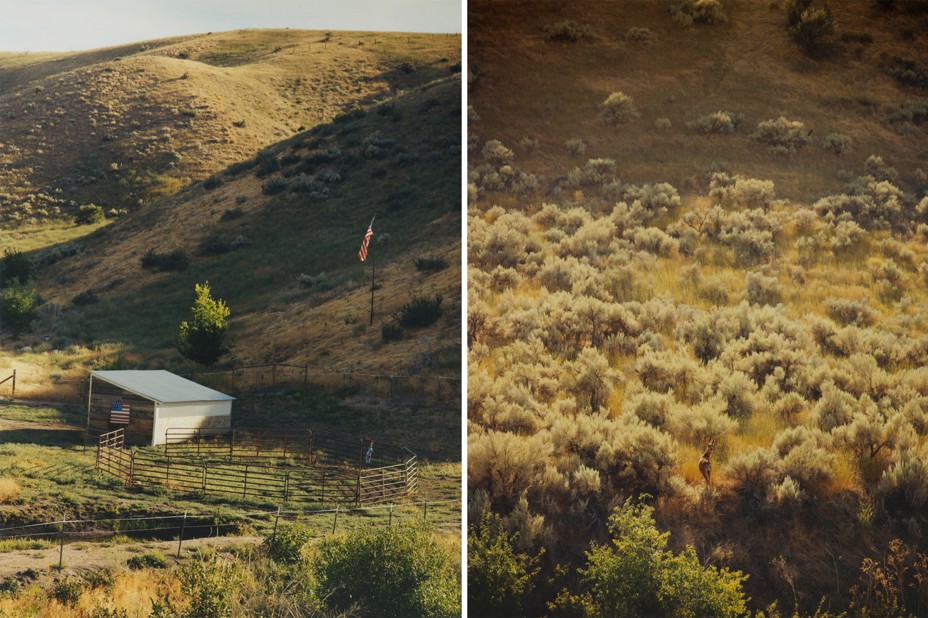 Emmett, Idaho
Emmett, Idaho
One morning a few weeks ago, Scott Malone arrived at the Bundy property to find it deserted. He’d come to pick up some pots and stoves he’d lent to Ammon for the apple harvest, and he found those in the driveway. Otherwise there was nothing. The trucks were gone. The house was cleaned out. The workshop was stripped. Bundy hadn’t even said goodbye—a noble act, Malone believed, meant to protect friends from being implicated.
A few days after they left, Lisa posted a farewell message on Facebook (“It’s not goodbye, it’s ‘I’ll see you later’”), but she and Ammon stopped answering my messages and calls. When I finally managed to get in touch with Ryan Bundy, he told me that his brother had tried to muster a group to fight with him, “but when it come down to it, only about half of ’em are willing to stand.” And so now, Ryan said, Ammon was a “refugee.”
Malone says he has no idea where Bundy is. Lawyers for St. Luke’s have heard that the family is in southern Utah, hardly an hour’s drive from where Cliven lives, and from where the family staged its first standoff nearly a decade ago. But Bundy seems to have kept his plan a secret, even from his father. “I don’t know why he quit,” Cliven told me a few days later. “My way of thinking is you can’t give up on something like this. You got a battle going, and it’s a terrible one, and you know”—he trailed off, seemingly at a loss—“I don’t know.”
Ammon Bundy still faces an ever-growing list of contempt-of-court charges, and there is still a warrant out for his arrest, with bail set at $250,000. For Rachel Thomas and Natasha Erickson, the news of his flight delivered both relief and frustration: relief because it meant that, for the moment at least, they would not have to testify in the scheduled contempt trial; frustration because, once more, he had escaped accountability. Seeing him behind bars wouldn’t have undone the pain of the past year and a half—Erickson was still considering leaving medicine, and even in New Zealand, Thomas’s son was still asking, “Mommy, that Ammon Bundy guy can’t come here, can he?”—but it would have brought a degree of closure, a feeling that justice had been served.
Law enforcement could still come looking for Bundy in Utah, or wherever he is, and bring him back to Idaho. And if that happens, he could face months or even years in jail. Even if it does not, St. Luke’s will soon claim possession of the home he left behind.
Standing there alone on the deserted property, Malone felt his own mix of emotions. He, too, was relieved: Had Bundy stayed and fought, the sheriff and his deputies would have gunned him down, Malone was sure of it. He, too, was frustrated: People’s Rights could have done more; people weren’t prepared to lay down their lives for freedom the way they used to be. And he was also heartbroken: The others may have been afraid, but he really would have died by his friend’s side. And now Ammon Bundy was gone. The specific era of American extremism that had begun a decade earlier at Bundy Ranch was, in some sense, over.
Ammon never returned my calls, but he did eventually send me a brief message via an encrypted app. “I have always told the truth,” he said, “and God will be my judge.”
His note called to mind something he’d once told me about his enemies. “I think most people over the years come to think that they’re doing what should be done,” he said. “And it doesn’t change the fact that what they’re doing is not right.”
.png)
 1 year ago
8
1 year ago
8


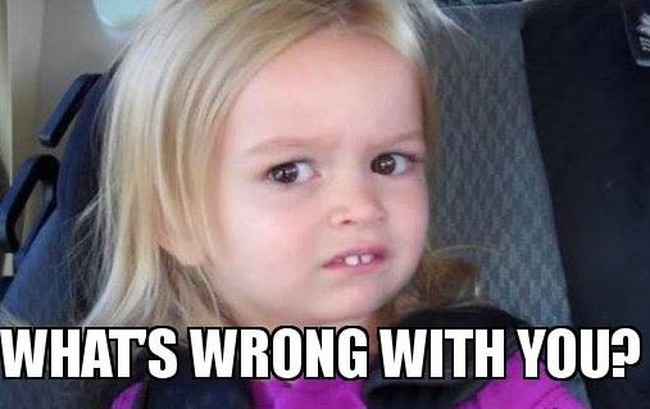





 English (US)
English (US)